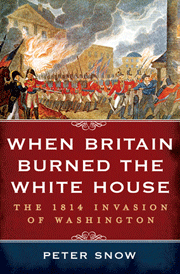Exclusive interview with author Peter Snow and a review of his new book about the War of 1812
Rating: 4 Stars
Review by Gabrielle Pantera
“It’s now been 200 years since the British came here to the White House under somewhat different circumstances,” said President Obama to British Prime Minister David Cameron during a visit to the White House in 2012. “I can see you’ve got the place a little better defended today,” said Cameron. They were referring to the British attack on Washington in 1814, in which the Brits burned down the White House. British Prime Minister Tony Blair had said in 2003, “I know this is kind of late, but sorry!”
 “Very few people here in Britain know that we invaded Washington and burned the White House,” says When Britain Burned the White House author Peter Snow. “And, even fewer know that it was a British attack that inspired the U.S. national anthem.” The “bombs bursting in air” were British.
“Very few people here in Britain know that we invaded Washington and burned the White House,” says When Britain Burned the White House author Peter Snow. “And, even fewer know that it was a British attack that inspired the U.S. national anthem.” The “bombs bursting in air” were British.
In August 1814, during the War of 1812, the United States army was defeated by British forces. President James Madison and his wife fled the White House as the British entered the city. Upon seeing a meal laid out the soldiers stopped to eat as they hadn’t been fed well on their campaign. Next, they went about setting the White House ablaze. The White House was wood with outer walls of stone. The destruction was total. Everything inside was destroyed. Less than a month later, American troops would win the Battle of Fort McHenry, where lawyer, author and amateur poet Francis Scott Key saw the American Flag waving proudly and began writing The Star Spangled Banner.
When Britain Burned the White House builds such suspense that you must continue reading.
Snow uses eyewitness accounts from both sides of the conflict to bring the personalities alive. On the American side we meet President James Madison, his wife Dolly, and Americans Joshua Barney, Sam Smith, War Secretary John Armstrong and Army Chief William Winder. On the British side is the overly zealous Admiral George Cockburn, the popular but cautious Major General Robert Ross, and the diarists James Scott and George Gleig. Dolly Madison saves the classic portrait of George Washington and helps furnish the reconstructed White House.
Three years ago Snow wrote To War with Wellington, a book about the Duke of Wellington’s victorious campaign against Napoleon. Snow’s inspiration for writing When Britain Burned the White House was one of his favorite characters in Wellington’s army, Major Harry Smith.
“A very brave and colorful fellow, in his autobiography I was astonished to read that after the Peninsular War was over he was on his way home with his new young Spanish wife, Juana Smith, when he was suddenly diverted to join a task force headed for the USA,” says Snow. “From the moment he left Bordeaux in May 1814 I was utterly captivated by his account of how the expedition headed for Washington, to give the Americans ‘a good drubbing’… those were the London government’s orders, in an effort to end the war of 1812.”
Snow is well known to British audiences as a veteran TV news presenter. Three of his other books have been made into television. “Two of them I filmed for the BBC with my son Dan, who is also a historian,” says Snow. “They were carried on U.S. TV on the Military Channel.” That includes Battlefield Britain and The World’s Greatest 20th Century Battlefields.
When Britain Burned the White House has been nominated for the Political History Book of the Year in London (2014).
Snow is currently writing an account of the Battle of Waterloo with his son Dan for publication by Andre Deutsch ahead of the bicentenary of the battle in 2015.
Snow is based in London. He born in Dublin, Ireland.
When Britain Burned the White House: The 1814 Invasion of Washington by Peter Snow. Hardcover: 320 pages, Publisher: Thomas Dunne Books (August 19, 2014), Language: English, ISBN: 9781250048288 $ 25.99
[adrotate group=”8″]
